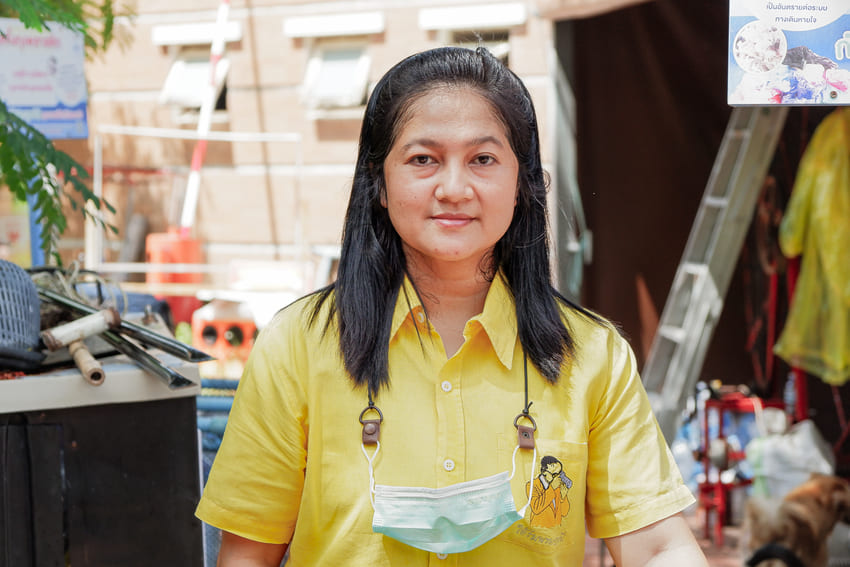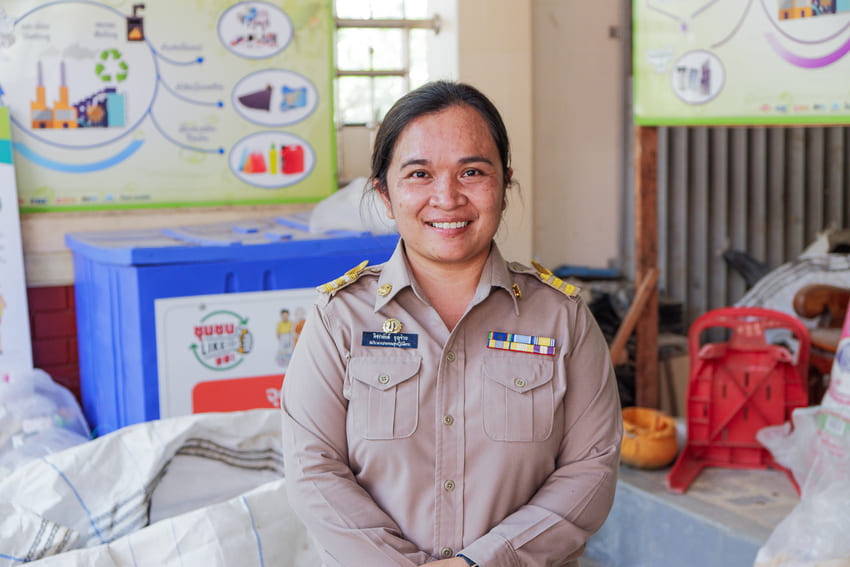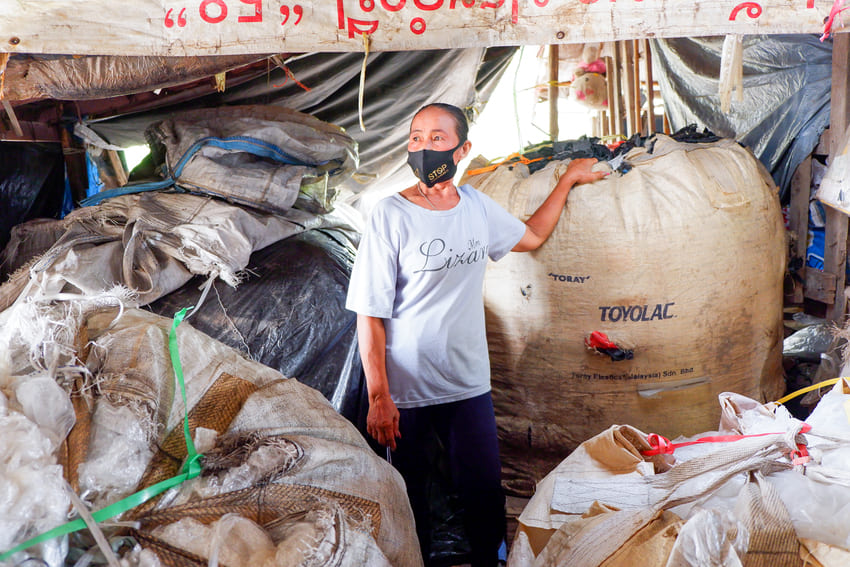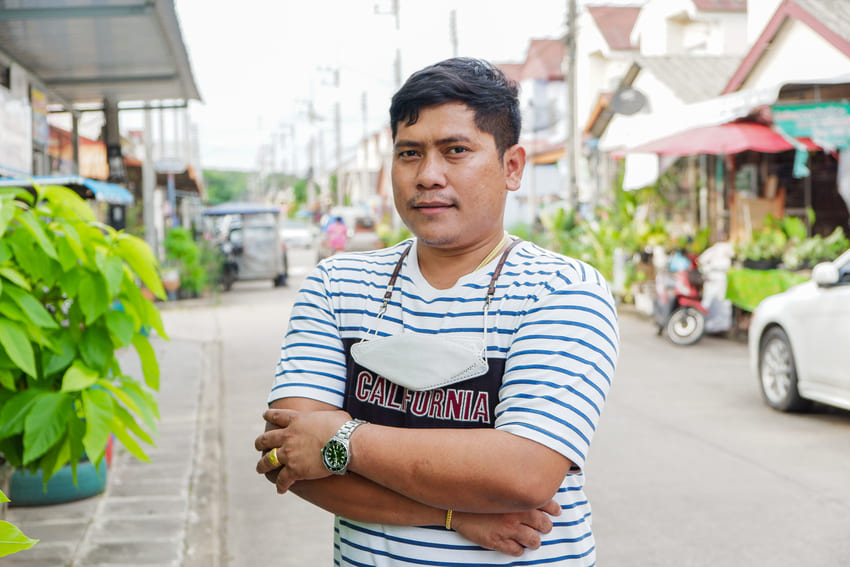From community efforts to government policies: 5 places that demonstrate how Rayong can become a model for plastic waste management
Excerpt: Waste pollutes Rayong as industrialization induces population boom. Communities, local government, and the public join hands to tackle the issue.
Rayong rarely gets much attention on other aspects save for its beautiful beaches. However, a closer look will reveal rapid transformation from a coastal fishery city to an industrial hub that the city has gone through within the last 30 years.
“The waste management budget from the tax money isn’t keeping up with the amount of our residents. A lot of people have moved into Mueang Rayong for its accommodation, market, and mall, but they actually work at factories in Map Ta Phut.”

Nattrika “Bent” Suemak, Head of Environmental Work Promotion at the City of Rayong, shared that they had long been encouraging waste reduction and recycling, but the City of Rayong had just recently started to modernize its activities. Facebook, LINE, and various apps are used to encourage people to sort their waste. She said that the project had gained unexpected popularity and cooperation, and now waste sorting and recycling had become daily routines for people in Rayong.
This is just one evidence among many to support the claim that Rayong is becoming a model for recycling and plastic waste reduction in Thailand.
School: a vital step toward change
Whether this statement is too far-fetched can be judged by the attitude of the children at Wat Lum Mahachai Chumpon Municipal School, a top 5 outstanding eco school as ranked by the Department of Environmental Quality Promotion. Khajonphan “Maem” Othong and Kamonnet “Oen” Bamrungphan, are two teachers who have been closely nurturing and observing their behaviors related to garbage, as well as working with the Department of Environment Engineering, Chulalongkorn University (CU) funded by the “Rethinking Plastics” project, to create tools to help manage waste.
"During this Covid-19 ordeal the children have to eat lunch in their classrooms. I’m starting to hear their complaints about disposable plastic food containers. Usually, the garbage can in the back of each classroom only has dust in it; now even two cans aren’t enough for the garbage from one classroom. Some of my pupils count their garbage by the piece. ‘Today, I ate sausages. I had plastic boxes, sauce packets, skewer sticks, and staple pins as garbage.’ The children here are like this."

The school tries to foster environmental awareness with every activity. For example, the cafeteria offers different portion sizes from small, medium, to large, to reduce food waste in the school.
Although almost all their waste was properly managed, there was one material that the school couldn't recycle: milk bags. Every morning, every child will receive 1 bag of milk. After it is drunk, the palm-sized plastic bag will leak residue milk that forms a puddle around the garbage. Having worked with the CU team, Maem sketched out a device that looks like a washing machine for them, the milk bag washer.
And a few months later, CU's research team completed it with the funding by “Rethinking Plastics”.
The mechanics of this milk bag washer are simple: the children discard their empty milk bags into the device, which will spin and wash them in bulk. The bags are left to dry inside and collected after.
This is the beautiful first step for Rayong. The children will pass on what they learn in school to their family, promoting environmental awareness from child to parents. When the parents change, the society as a whole also changes.
The municipality’s heartfelt mission
Back with Bent at the Environmental Work Promotion, City of Rayong, her modest office was surrounded by tents containing tons of plastic waste that the municipality had prepared for garbage pickers to resell to the recycling factory.
"Actually, we’ve been encouraging people to sort their garbage for decades. But people show a lot of enthusiasm for mobile apps. As for the waste bank, we’ve made it so that people can cash their waste credits after showing us receipts from department stores. With this, we no longer need to stock up on goods. When people want to throw out large objects like cabinets or beds, they can leave them beside their garbage cans in front of the house for us to collect and donate to Suankaew Foundation."
To facilitate transportation, CU designed a plastic waste compactor under the pilot project.
"The compactor helps us save space in transportation. This large pile of plastic bags weighs 300 kilograms. It was all a truck can carry in one trip, but with the compactor a truck can carry 1 metric ton of plastic, cutting 3 trips of transportation."
Suthisa “Min” Samithiwetcharong, a researcher from CU who designed the garbage compactor and often worked with the people in Rayong, cordially explained.
Min said that this compactor helps improve the quality of life for the people working with waste. Garbage pickers would previously have to walk in the sun to the landfill to salvage things to sell, but now recyclables are sorted and ready for pickup from the municipality. Thus the machine helps improve the work of garbage pickers, as well as reduce fuel costs, transportation time and carbon footprint, and allows them more spare time.
As luck would have it, a truck came in to pick up sorted garbage during our visit. We’d later follow this pickup truck to see where this truckful of plastic waste ends up, but before that was a visit to Thapma Temple, which is known to accept plastic waste as an offering, as well as its policy to systematically develop ecotourism.
The quiet Buddhist temple that is the heart of Thabma community is another destination in Rayong with a designed compactor. The temple’s new role as a waste management center of the sub district has gained widespread attention. While it doesn’t hold tons of sorted plastic like Rayong City Municipality, it gathers the community’s waste and forwards it to garbage pickers to recycle in the same fashion.
In the sermon hall Pitchanan “Aer” Bunchuay, an environment officer of Thapma Subdistrict Municipality, explained the various projects of Thabma Temple, along with Phra (Thai term for monk) Pong, a Buddhist monk devoting himself to community development, who initiated the plastic offering project and many more.

"When I moved here 10 years ago, there were already problems with garbage because of the rapid industrialization of the community, with fishermen and rubber farmers selling their land. This is a residence area of workers from the industrial zone. The population of the sub district has leapt from a few thousand to 25,000 within a couple of years, resulting in 3-4 times increased garbage. As a result, the authority’s planned budget cannot keep up."
Aer explained the changes were too sudden for the budgets of the local government that caused the people to take action themselves with for example the green temple.
"After every temple event, the abbot always reminds our believers not to bring plastic bags when they make offerings. People are advised to bring food in carriers and transfer it directly to the plates we prepare and sort their garbage offering. This is considered meritorious. We keep the garbage for the municipality to collect once a month and make ten to twenty thousand baht that go to the electricity bill. We’ve already been selling to garbage pickers before this."
Phra Pong, who was born and grew up in Rayong, has been with the temple since he was a novice. He has seen the changes of Thabma sub district firsthand. It was the abbot and Phra Pong’s idea that the temple takes part in waste management. Their sermon hall is surrounded by donation bins for plastic that the community brought in for recycling. Some just donated it, while others took a few trays of eggs in exchange.
Aer added that most of the community have progressed from being ignorant to sorting PET, HDPE, and PPE plastics by themselves in a few years. Some people even bring plastic covers of car parts from factories to donate. The public, the temple, and the municipality here are combining their resources and labors to turn the temple into an ecotourism attraction, to send a message: “If we can do it, shouldn’t you try?”
Aunty Tong
That afternoon, we drove out of Rayong city for almost an hour. In the middle of an open field is Aunty Tong's house, the destination of the garbage truck that had come to collect plastic from Bent's transfer station in the morning. Aunty is well-known among the people in the recycling business. Her house is a zinc hut crowded with several tons of waste plastic bags. While we were talking, pickup trucks continuously came and went to bring the garbage to the recycler. Her house is the last stop before these bags reach the recycling center.
"I’ve always worked with these bags. I’d been in Nong Khaem before moving to Rayong landfill in '97. When the Rayong landfill was full, I moved again to Sunthorn Phu subdistrict since we weren’t allowed to sort garbage in the city area because of the smell. This place isn’t far from Sunthorn Phu Temple’s landfill. Years ago, my husband and I had to dig through the garbage ourselves. We left home at 4 or 5 in the morning and returned late in the morning when the sun got too hot. But I’m old now, so I just buy and resell stuff."

In the past, Aunty Tong used to scavenge for plastic bags and bottles with a rake in the municipality landfill that contained untreated waste including anything from food scraps to furniture. When the pit was full, it was covered with soil and prepared for the next layer of refuse. Aunty called the sack containing dirty garbage from her scavenging "pit bag". This garbage needed to be cleaned with water to a degree before she could sell it. Her homemade cleaning equipment is a small basin with a motor to keep the water running, similar to the school's milk bag washer.
Although Aunty’s life hadn’t changed much in terms of economy, she told us that work was much more difficult before. She had to go scavenging the garbage to sell to the recycler herself. Besides, plastic wasn't worth so much at the time.
The obvious change is that, when the community sorts their waste, garbage pickers like Aunty Tong can buy treated garbage to resell without the need to toil in the sun like before. In addition, the recycling industry gains more participants including factories, community, municipality, and garbage pickers. This creates a society of mutual benefit, and it ends up easing the burdens of Aunty Tong.
Baan Eua-Arthorn Community
The last stop took us to the Baan Eua-Arthorn housing project Wang in Wa, Rayong. This community is an example of the community-wide efforts, from knowledge sharing, awareness building, jobs and income generation, to the improvement of plastic waste management.
The first thing greeting visitors at the entrance are tanks of EM compost using food scraps from the community, which everyone can take for cleaning. The community center is lined with prizes and proof of being featured in the media and also showcases various products including woven bags, household items, bricks, artificial flowers, all made of plastic waste from the community. These products didn’t pop out of thin air, they needed designing and expertise of the residents who made time to create these products to earn money for the village.

"Our garbage used to give off a terrible smell. It was mixed with the chemical odor from nearby farming until we couldn’t tell which was which anymore. We made some complaints, but I thought that things would go faster if us villagers who knew the problem better took initiative. I started researching about plastic types and how to handle perishable waste, then printed it out and went door to door to tell the villagers by myself. They thought I was a municipal officer, but it did make people more cooperative. Before, the municipality couldn’t reach the bottom of our rotten garbage cans no matter how much they collected, but now we make money and get a lot of attention as a model community after managing things ourselves."
Residents for example hang buckets of food scraps in front of their houses for the volunteers to collect and properly dispose of as a part of their daily routine. The waste bank here offers household supplies in exchange for sorted plastic. In addition, Pum also showed how the newly arrived plastic shredder works. The shredded plastic is easier to use in the production of various items. In addition, the community also uses the designed compactor by CU.
Rayong is gracefully moving forward sustainability in response to sudden changes. But whether it will become and stay a model city in recycling remains to be seen.
The visit already showed efforts from the local government and the public. The way ahead will be depending on the cooperation from both sides, including awareness raising, policy enforcement with incentives, government budgets, as well as cooperation from private businesses.
More about the “Rethinking Plastics” Pilot activities in Rayong here: Rethinking Plastic - Households Fit for Recycling (rethinkingplastics.eu)
Text and pictures: Harmish Muszid for “Rethinking Plastics”

